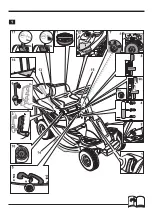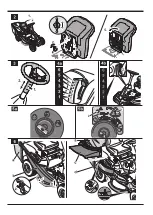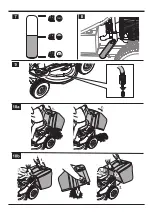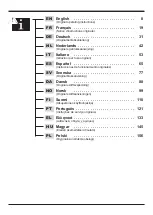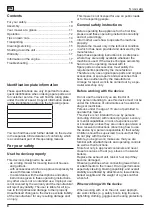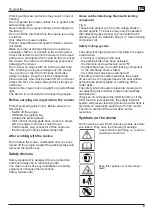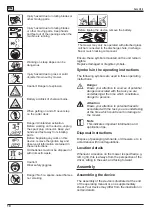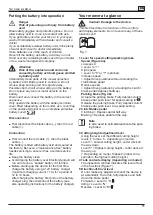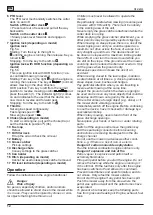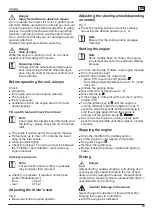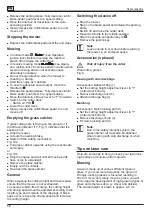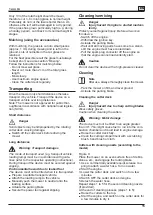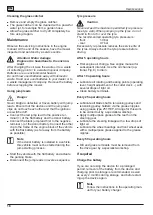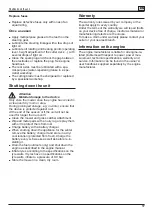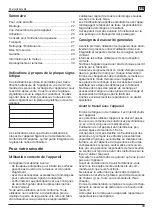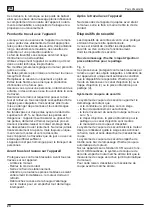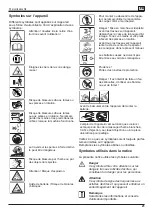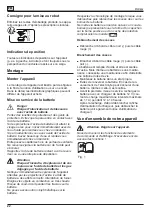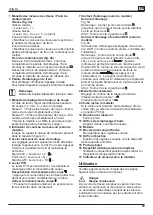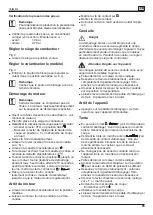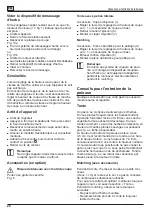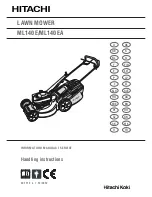
11
Your mower at a glance
EN
Putting the battery into operation
Danger
Risk of poisoning and injury from battery
acid
Wear safety goggles and protective gloves. Do not
allow battery acid to come into contact with skin.
If you get battery acid on your face or in your eyes,
wash off immediately with cold water and consult a
doctor.
If you accidentally swallow battery acid, drink plenty
of water and consult a doctor immediately.
Store batteries out of the reach of children.
Never tilt the battery, as battery acid may run out.
Hand over any remaining battery acid to your dealer
or to a waste management company.
Attention
Risk of fire, explosion and corrosion
caused by battery acid and gases emitted
by battery acid
Immediately clean parts of the mower splashed
by battery acid. Battery acid is corrosive. Do not
smoke, keep burning and hot objects away.
Possible short-circuit when working on the battery
Do not place any tools or metal objects on the
battery.
Disconnect and connect the battery in the correct
sequence.
Only operate the battery with the battery-terminal
cover fitted (depending on the model, as a cover flap
on the positive terminal or as a complete protective
battery cover)
.
Disconnection
■
First disconnect the black cable (–), then the red
cable (+).
Connection
■
First connect the red cable (+), then the black
cable (–).
The battery is filled with battery acid and sealed at
the factory. But even a “maintenance-free” battery
needs servicing to ensure it has a certain service
life.
■
Keep the battery clean.
■
Avoid tipping the battery over Electrolyte liquid will
run out of even a “sealed” battery if it is tilted.
■
Before starting up the device for the first time,
charge the battery using a 12V battery charger
(maximum charging current 1.1A) for a period of
12 to 14 hours.
After charging the battery, first pull out the battery
charger plug, then disconnect the battery (see
also operating instructions for the battery charger).
Your mower at a glance
Caution! Damage to the device.
This first describes the functions of the controls
and display elements. Do not execute any of these
functions yet!
Fig. 1
1 Lever for speed settings/parking brake
Speed (Figure 4a):
Low speed
= Lever to "1".
High speed
= Lever to "6" or "7" (optional).
Increase speed
= Adjust drive positions without actuating the
clutch/brake pedal.
Reduce speed
= Adjust drive positions by actuating the clutch/
brake pedal (depress halfway).
Parking brake (fig. 4b):
Actuate the parking brake: Fully depress clutch/
brake pedal, push lever for speed setting to .
Release the parking brake: Fully depress clutch/
brake pedal, push lever to a speed setting.
2 Clutch/brake pedal
Clutching = Depress pedal half way.
Braking = Depress pedal all the way.
Note
Is also used to activate/deactivate the park-
ing brake.
3 Cutting height adjustment lever
Using the lever set the different cutting height
levels (1 to max. 5 - depending on model).
Level 1 = Lowest cutting height - cutter deck all
the way down.
Level 5* = Highest cutting height - cutter deck all
the way up.
(* Depending on model. Highest number corre-
sponds to the highest cutting height.)
4 Tank contents display (depending on model)
The inspection window indicates the level of fuel
in the fuel tank (Figure 7).
5 Direction-of-travel lever
Do not make any adjustments until the device is
at a standstill. To do this, fully depress and hold
down the brake pedal.
Forwards = Lever to “F/ ”
Idling = Lever to “N”
Reverse = Lever to “R/ ”



